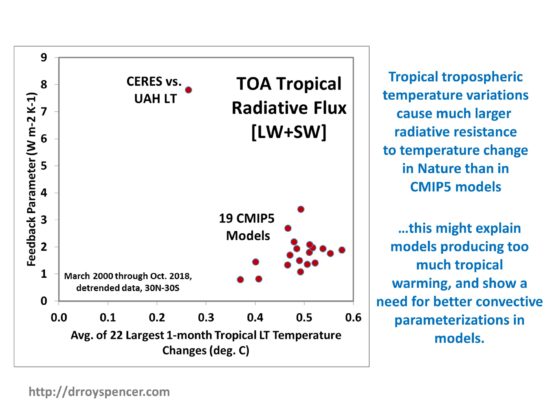The radiative resistance to global temperature change is what limits the temperature change in response to radiative forcing from (say) increasing CO2, or the sun suddenly deciding to pump out a 1 percent more sunlight.
If the climate system sheds only a little extra energy with warming, it warms even more until radiative energy balance is restored. If it sheds a lot of energy, then very little warming is required to restore global energy balance. This is the climate sensitivity holy grail, and it will determine just how much warming results from increasing CO2 in the atmosphere.
John Christy and I are preparing a paper based upon Dept. of Energy-sponsored research explaining why the tropical troposphere hasn’t warmed as much in nature as in climate models. (The discrepancy exists for surface temperature trends; for both RSS and UAH tropical tropospheric trends; as well as for global reanalysis datasets). Danny Braswell and I did a lot of research on this subject about 5-10 years ago, and published several papers.
Without going into the gory details of why it is so difficult to measure “feedbacks” (how strong the climate system radiatively resists a temperature change in response to radiative forcing), I’m going to present one graph of new results from our work that suggests where the problem with the models might be.
The plot I will show is based upon month-to-month variations in area-averaged tropical (30N-30S) tropospheric temperatures. When those temperature changes are the largest, we expect to see the clearest signal of radiative resistance (negative “feedback”) which, by definition, is a response to that temperature change. In contrast, if the month-to-month temperature change was zero, any change in radiative flux would result in an infinite feedback parameter, which is clearly unphysical.
So, let’s focus on the biggest observed temperature changes. If we take the 10% of the 224 months of detrended CERES satellite radiative flux data (March 2000 through October 2018) which have the LARGEST month-to-month temperature changes (warming and cooling) in detrended UAH LT data, and compare them, we get the following plot of diagnosed feedback parameter (flux change divided by temperature change) versus average absolute temperature change. Also included in the plot are the results computed in the same manner from 19 different CMIP5 climate models, where I have used the model surface to 500 mb geopotential thickness converted to temperature to approximate the UAH LT product.

There is a clear discrepancy between the 19 different climate models and the observations. The observations suggest a much larger resistance to a temperature change (vertical axis) than the models do, by over a factor of 4, for the same temperature change. This large feedback parameter is probably why the observations also show the smallest month-to-month temperature changes (horizontal axis) compared to the models (about 50% weaker than the models): the radiative resistance to temperature change actually reduces the month-to-month temperature fluctuations.
What Does this Mean?
The results are qualitatively consistent with Lindzen’s “infrared iris” effect, as we find the discrepancy between models and observations is larger in the infrared (LW) component of radiative flux than in the reflected solar (SW) component (SW and LW plots not shown here).
Interestingly, I had to exclude the GISS model results because they show increasing temperatures lead to a feedback parameter with the wrong sign, which is not physically possible for a stable climate system. It could be the GISS model has issues with energy conservation.
Just how these results would impact global warming projections remains to be seen. First, improvements in how tropical convection and its associated clouds and vertical distributions of water vapor *change with temperature* would have to be put into the models. Then, the models would have to be run with increasing CO2 to see whether model projections of warming are reduced.
My prediction is that, if this was done, the models would produce considerably less tropical warming than they currently do. This might also extend to reduced warming rates outside of the tropics, since the tropics export excess heat energy to higher latitudes. If less heat builds up in the tropics, less will be exported out of the tropics.
We have many more results on this issue, including comparisons to a simple time-dependent forcing-feedback model that can replicate both the observations and the CMIP5 model behavior.

 Home/Blog
Home/Blog



